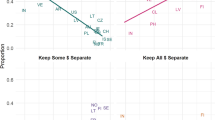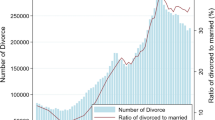Abstract
A core assumption in conventional poverty measurement is that household members share equally in total household income. This paper focuses on heterosexual couple households and asks to what extent male and female partners may derive different benefits from total couple resources. Drawing on the 2010 Irish Survey on Income and Living Conditions module, we examined the couple financial regime, by which we mean which partners received income, whether the income was from work, the extent to which income was contributed for the benefit of other household members and responsibility for decision-making. We explored whether the couple’s financial regime was associated with different living standard outcomes for the partners. Among the findings was the beneficial impact of having income from work and of shared responsibility for decision-making. The paper concludes by pointing to some implications for our understanding of power and bargaining in couples.

Similar content being viewed by others
Notes
This paper draws on the output of a research programme for the Analysis and Measurement of Poverty and Social Exclusion funded by Ireland’s Department of Social Protection under the National Action Plan for Social Inclusion 2007–2016 (Office for Social Inclusion 2007).
Across the items, the partners give matching responses in nearly nine out of ten cases (Watson et al. 2013).
There may have been differences between partners in responses on heating where, for example, someone at home during the day might do without heating but heating is turned on in the evening when others are at home.
The Cronbach’s alpha for the items, assessed based on tetrachoric correlation coefficients was 0.79 (and 0.50 if assessed using Pearson correlation coefficients).
The model is based on weighted data with robust standard errors, using Stata’s “svy” routine. The model-estimated results are average marginal effects (AME) calculated using Stata’s “margins” command (Williams 2012).
References
Apps, P. F., & Rees, R. (1988). Taxation and the household. Journal of Public Economics, 35(3), 355–369. doi:10.1016/0047-2727(88)90037-0.
Apps, P. F., & Rees, R. (2007). Household Models: An Historical Perspective (CESifo Working Paper Series No. 2172). Retrieved from http://ssrn.com/abstract=1077061.
Becker, G. S. (1981). A Treatise on the Family. Cambridge, MA: Harvard University Press.
Bergstrom, T. C. (1997). A survey of theories of the family. In M. R. Rosenzweig & O. Stark (Eds.), Handbook of Population and Family Economics. Amsterdam: Elsevier Science.
Blood, R., & Wolfe, D. (1960). Husbands and Wives: The Dynamics of Married Living. Glencoe, IL: Free Press.
Bonke, J., & Browning, M. (2009a). The allocation of expenditures within the household: A new survey. Fiscal Studies, 30(4), 461–481.
Bonke, J., & Browning, M. (2009b). Pooling of Income and Sharing of Consumption Within Households (Discussion Paper Series No. 428). Oxford: Department of Economics.
Brines, J. (1994). Economic dependency, gender and the division of domestic labour at home. American Journal of Sociology 100(3), 652-688. Retrieved from www.jstor.org/stable/2782401.
Browning, M., Bourguignon, F., Chiappori, P.-A., & Lechene, V. (1994). Income and outcomes: A structural model of intra-household allocation. The Journal of Political Economy, 102(6), 1067–1096. Retrieved from www.jstor.org/stable/2138780.
Bütikofer, A., Gerfin, M., & Wanzenried, G. (2009). Income pooling and the distribution of individual consumption among couples in Switzerland. Retrieved from http://staff.vwi.unibe.ch/gerfin/downloads/poolingsharing_oct09.pdf.
Cantillon, S. (2013). Measuring differences within households. Journal of Marriage and Family, 75(3), 598–610. Retrieved from www.jstor.org/stable/23440903.
Cantillon, S., & Nolan, B. (1998). Are married women more deprived than their husbands? Journal of Social Policy, 27(2), 151–171.
Cantillon, S., & Nolan, B. (2001). Poverty within households: measuring gender differences using nonmonetary indicators. Feminist Economics, 7(1), 5–23. doi:10.1018/135457001316854692.
Chen, Z., & Woolley, F. (2001). A Cournot-Nash model of family decision making. Economic Journal, 111(474), 722–748. Retrieved from www.jstor.org/stable/798410.
Chiappori, P.-A. (1992). Collective labor supply and welfare’. Journal of Political Economy, 100(3), 437–467. Retrieved from www.jstor.org/stable/2138727.
CSO (Central Statistics Office). (2012). Survey on Income and Living Conditions (SILC): 2010. Dublin: Central Statistics Office. Retrieved from http://www.cso.ie/en/media/csoie/releasespublications/documents/silc/2010/silc_2010.pdf.
CSO (Central Statistics Office). (2013). Survey on Income and Living Conditions (SILC): 2011 and Revised 2010 Results. Dublin: Central Statistics Office.
Evertsson, L., & Nyman, C. (2014). Perceptions and practices in independent management: Blurring the boundaries between “mine”, “yours” and “ours”. Journal of Family and Economic Issues, 35(1), 65–80. doi:10.1007/s10834-012-9348-6.
Gershuny, J. (1992). The Domestic Labour Revolution: A Process of Lagged Adaption? Social Change in Contemporary Britain. Cambridge: Polity Press.
Goode, J., Callender, C., & Lister, R. (1998). Purse or Wallet? Gender Inequalities and Income Distribution within Families on Benefits. London: Policy Studies Institute.
Grossbard-Shechtman, A. (1984). A theory of allocation of time in markets for labor and marriage. Economic Journal, 94(376), 863–882.
Haddad, L., & Kanbur, R. (1990). How serious is the neglect of intrahousehold inequality? Economic Journal, 100(402), 866–881.
Holden, K. C. (2011). Introduction to the thematic issue on family finance. Journal of Family and Economic Issues, 32(4), 552–553. doi:10.1007/s10834-011-9278-8.
Lauer, S. R., & Yodanis, C. (2011). Individualized marriage and the integration of resources. Journal of Marriage and Family, 73(3), 669–683. doi:10.1111/j-1741-37372011.00836x.
Layte, R. (1999). Divided Time: Gender, Paid Employment and Domestic Labour. Aldershot: Ashgate.
Lee, J., & Pocock, M. L. (2007). Intrahousehold allocation of financial resources: evidence from South Korean individual bank accounts. Review of Economics of the Household, 5(1), 41–58. doi:10.1007/s1150-007-9004-3.
Lundberg, S. J. & Pollak, R. A. (1993) Separate sphere bargaining and the marriage market. Journal of Political Economy, 101, 988–1010. Retrieved from www.jstor.org/stable/2138569.
Lundberg, S. J., Pollak, R. A., & Wales, T. J. (1997). Do husbands and wives pool their resources? Evidence from the United Kingdom child benefit. The Journal of Human Resources, 32(3), 463–480. Retrieved from www.jstor.org/stable/146179.
McElroy, M. B. & Horney, M. J. (1981). Nash bargained household decisions: Toward a generalization of the theory of demand. International Economic Review, 22(2), 333–349. Retrieved from www.jstor.org/stable/2526281.
Morris, L. (1990). The Workings of the Household. Cambridge, MA: Polity Press.
Morris, L., & Ruane, S. (1989). Household Finance Management and the Labour Market. Aldershot: Avebury.
Nyman, C., & Dema, S. (2007). An overview: Research on couples and money. In J. Stocks, C. Diaz, & B. Halleröd (Eds.), Modern Couples Sharing Money, Sharing Life. Basingstoke: Palgrave Macmillan.
Office for Social Inclusion. (2007). National Action Plan for Social Exclusion, 2007–2016. Dublin: Stationery Office.
Pahl, J. (1989). Money and Marriage. Houndmills: Macmillan Education Ltd.
Pahl, J. (2004). Individualization and patterns of money management within families. In Paper presented at ESPAnet conference, Oxford University, 9–11 September.
Phipps, S. & Burton, P. (1998). What’s mine is yours? The influence of male and female incomes on patterns of household expenditures. Economica, 65(260), 599–613. Retrieved from www.jstor.org/stable/2555190.
Rake, K., & Jayatilaka, G. (2002). Home Truths: An Analysis of Financial Decision Making Within the Home. London: Fawcett Society.
Rose, D., & Harrison, E. (2007). The European socio-economic classification: A new social class schema for European research. European Societies, 9(3), 459–490.
Rottman, D. (1994). Income Distribution Within Irish Households: Allocating Resources Within Irish Families (Combat Poverty Agency Research Report Series No. 18). Dublin: Combat Poverty Agency.
Samuelson, P. A. (1956). Social indifference curves. Quarterly Journal of Economics, 70(1), 1–22.
Skogrand, L., Johnson, A. C., Horrocks, A. M., & DeFrain, J. (2011). Financial management practices of couples with great marriages. Journal of Family and Economic Issues, 32(1), 27–35. doi:10.1007/s10834-010-9195-2.
Stier, H., & Lewin-Epstein, N. (2000). Women’s part-time employment and gender inequality in the family. Journal of Family Issues, 21(3), 390–410. doi:10.1177/019251300021003006.
Thomas, D. (1990). Intra-household resource allocation: An inferential approach. Journal of Human Resources, 25, 635–664. Retrieved from www.jstor.org/stable/145670.
Vogler, C. (1994). Money in the household. In M. Anderson, F. Bechhofer, & J. Gershuny (Eds.), The Social and Political Economy of the Household. Oxford: Oxford University Press.
Vogler, C., Lyonette, C., & Wiggins, R. D. (2008). Money, power and spending decisions in intimate relationships. The Sociological Review, 56(1), 117–143. doi:10.1111/j.1467-954x.2008.00780x.
Watson, D., Maître, B., & Cantillon, S. (2013). Implications of Income Pooling and Household Decision-making for the Measurement of Poverty and Deprivation: An Analysis of the SILC 2010 Special Module for Ireland (Social Inclusion Technical Paper No. 4). Dublin: Department of Social Protection.
Watson, D., Maître, B., & Whelan, C. (2012). Work and Poverty in Ireland: An Analysis of the CSO Survey on Income and Living Conditions 2004–2010. Dublin: ESRI and Department of Social Protection.
Williams, R. (2012). Using the margins command to estimate and interpret adjusted predictions and marginal effects. The Stata Journal, 12(2), 308–331.
Wilson, G. (1987). Money in the Family. Aldershot: Avebury.
Author information
Authors and Affiliations
Corresponding author
Appendix
Appendix
See Table 6.
Rights and permissions
About this article
Cite this article
Cantillon, S., Maître, B. & Watson, D. Family Financial Management and Individual Deprivation. J Fam Econ Iss 37, 461–473 (2016). https://doi.org/10.1007/s10834-015-9466-z
Published:
Issue Date:
DOI: https://doi.org/10.1007/s10834-015-9466-z




